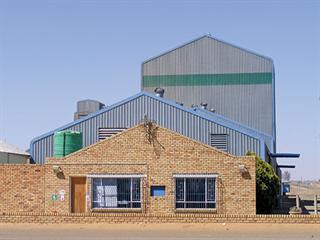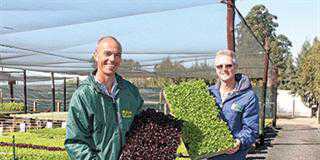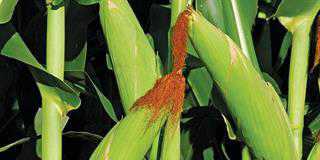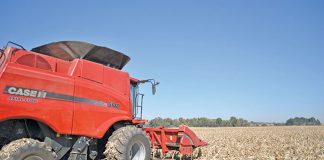
Anthony Evans is a third- generation farmer in the Viljoenskroon district. His great-grandfather, David Evans, emigrated to South Africa from Wales in 1860 and earned his living as a transport rider moving goods from Durban to Barberton and Kimberley. David’s son, John, known as JK, bought land in Viljoenskroon, where he farmed with his sons Bruce and Rhys.
After the Second World War, Rhys, an astute businessman, formed the Rhys Evans Group on the farm Huntersvlei.
Rhys’s son, Anthony, started farming in 1968 and took over the leadership of the business when his father died in 1972. David, Anthony’s son, has recently joined the family business. The Rhys Evans Group farms maize, groundnuts, sunflower and soya beans. A subsidiary, the RE Groundnuts shelling and processing plant, exports groundnuts, mainly to Germany and Japan. Peanut butter and roasted peanuts are produced for the local market.
The Huntersvlei Farm Fresh Abattoir is another subsidiary. By acquiring the local abattoir in Viljoenskroon, the group has gained far greater control over the marketing of their 6 200-pig production operation. Huntersvlei Sussex comprises a 490-cow Sussex stud and a 1 050-cow commercial Sussex herd. The commercial animals are earmarked for feedlotting and weaner production.

Anthony Evans (front) with Arno Cronje, general manager (left) and Anthony’s son, David.
Crop rotations
Maize is planted in rotation, with groundnuts (three years maize, one year groundnuts), sunflower (two years maize, one year sunflower) and soya beans (one year maize, one year soya beans). Maize planting takes up 2 700ha, groundnuts 242ha, soya beans 67ha, sunflowers 153 ha, and fodder sorghum 80ha. The 2012 and 2013 production seasons were the toughest years that Anthony can remember.
“Last year was the driest season we’ve had since 1993 and the second-driest year in the past 60 years. Then, from September 2012 to August 2013, we had 600mm of rain, which was close to average but the rain came in sporadic showers.” The average maize yield in the 2012/2013 season was 3t/ha, compared with the long-term average of 5,5t/ ha. Groundnut production dropped from an average 1,5t/ ha to 0,8t/ha.
Soil management
According to Anthony, several reasons have led to their success of their operation. “One of the primary factors affecting crop production on our lands was the system of deep sandy soil cultivation practised and promoted by tillage and sandy soil specialist Carel Koch from the 1970s. ‘Ripping on the row’ revolutionised grain production in our sandy soils,” he recalls.
GM seed cultivars and precision farming have also been major drivers of progress. Anthony and his team are currently expanding their no-till operation.
Rhys Evans Group general manager Arno Cronje, who joined the operation in 1991, says that implementing precision farming practices from 2003 has turned crop production around. “We’ve phased out marginal lands and concentrated on high- potential lands. We have varying soil types, including deep sandy soils with 4% to 7% clay content and sandy loam soils with 8% to 12% clay content.”
Soil structure is analysed to determine depth, type, texture, and water retention. Soil chemistry, pH, nutrient levels and acid salts are also examined so that production can be planned in detail and costs reduced where possible. Fertiliser is applied according to the potential of the specific land or portion of the land rather than indiscriminately broadcast.
Conserving water
Moisture management is vital for sustainable and profitable long-term crop production. Crop lands have been re-designed and contoured to prevent run-off and conserve moisture. “No-till cropping also improves moisture holding capacity, and good ground cover means improved yields,” says Anthony. It was increases in production and input costs that led the team to consider no-till as a cultivation option. “During the last two years, we’ve spent a lot of time and effort learning more about no-till,” says Arno.
After a trip to Argentina in 2011, they planted a 50ha trial to no-till maize, soya beans and groundnuts. According to Arno, the initial results are promising and he and his team plan to increase the area under no-till next season.
Precision farming
Cultivation is based on crop and soil type. Deep sandy soils are ripped to a depth of between 600mm and 800mm. Row widths are between 1,5m and 0,9m and wheel movement on the land is synchronised to a total width of 7,8m. Arno says that wheel synchronisation is important from ploughing to harvesting. The same track is used to avoid criss-crossing the land with heavy machinery and to keep compaction down.
“After we’ve applied ammonia gas, we don’t disturb the soil for the rest of the season. Leaving the stover on after the grain crop has been harvested protects it from wind erosion,” explains Arno. A chisel plough is used for primary cultivation on the sandy loam soils to a depth of between 300mm and 400mm, depending on the clay content. Primary cultivation is followed with shallow cultivation, if necessary, and wheel traffic synchronised.
Maize is planted in a six-row x 90cm system. Each six-row group has a total width of 5,8m. According to Arno, this narrow planting pattern creates shade, limits moisture loss and inhibits weed development. In addition, water run-off is reduced.
To help in the fight against wind erosion, the team uses chisel ploughs and plants cover crops on groundnut lands. “In the past, groundnut lands were left bare after harvesting. This year, we planted triticale as a cover crop after the harvest, which was a good move.
The cover makes it possible for us to plant no-till maize after groundnuts,” Arno explains. Fertilisation – during the pre-plant, planting and top dressing phases – is based on soil potential, previous yield and crop. The previous season’s rain and the next season’s forecast is also taken into account. Lime, phosphate and potassium are applied according to the 1ha grid sample results.
Leaf and sap samples are taken regularly during the growth period to determine the crop’s nutritional needs, and foliar feed is added if necessary. “We have about 2 000t of pig and cattle manure available every year which we compost with hay or groundnut shells,” says Anthony. The compost covers an area of about 200ha. It cuts fertilisation costs and improves yield by as much as 1t/ha. “Our research has shown an application rate of 15t/ha to be most effective,” Anthony adds.
Research trials on site
Seed companies have run cultivar trials on the Evanses’ lands for the past 30 years. Anthony says that observing a trial in progress has helped his team make informed choices. “We can follow the process from planting to harvest and see how the cultivars perform on our land. We also run fertiliser trials that have been good for our grain production operations.” The Rhys Evans Group, GWL and Agricol are currently running trials on groundnut seed cultivars from the USA, Argentina and Australia. “We arrange annual information days so that we can share our knowledge and experience with other farmers,” says Anthony.
Tackling diseases
Grey leaf spot in maize is a problem in the Free State, according to Arno. Diplodia stem- and cob-rot and Fusarium root- and stem rot affects maize. Eelworm and Cercospera leaf spot, Phoma mould and Botrytus occurs in groundnuts. Bollworm is a problem with soya beans, while sunflowers are affected by Sclerotinia.
“We manage pests and diseases topically and through rotational planting,” says Arno. Gerbils are controlled chemically before and during the planting season. In addition, owl boxes and perches have been erected to encourage owls to the farm. Pig weed, khaki weed, wild lucerne, horse weed and Senecio sp. are common problem plants. Finger grass is a serious problem in maize lands late in the season. Weeds are sprayed off a week before planting and again after planting.
Efficiency and the value chain
“I learned early in my farming career that high yields are more important than high hectares,” Anthony says. “Because we stopped planting marginal lands and introduced cattle, we were able to survive some difficult years. “The abattoir and the groundnut processing plant have also added tremendous value to our operation.”
Phone Arno Cronje on 056 343 3311 or email [email protected] or Anthony Evans at [email protected]













